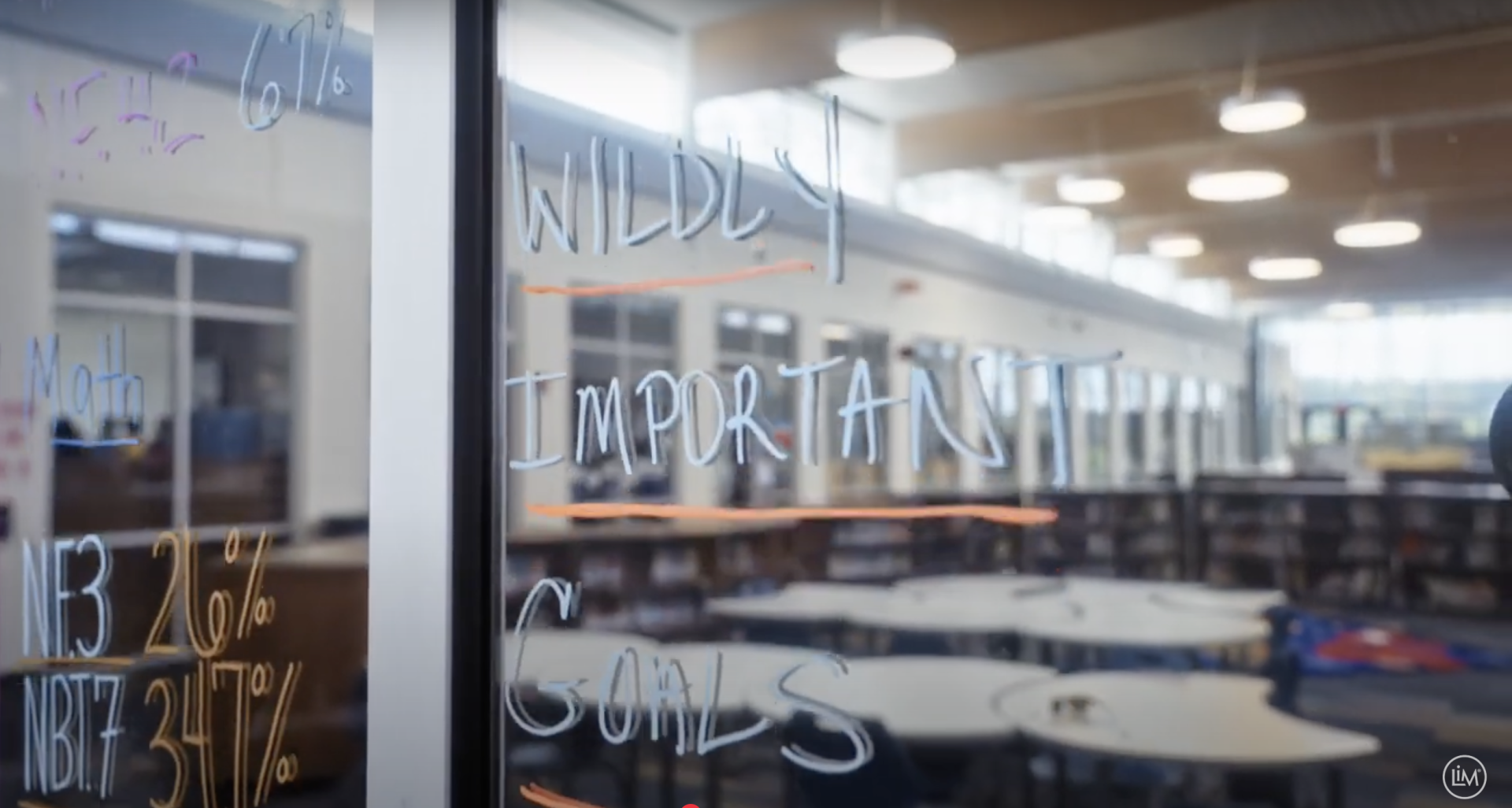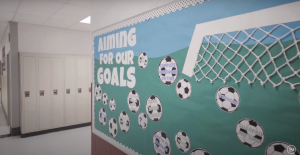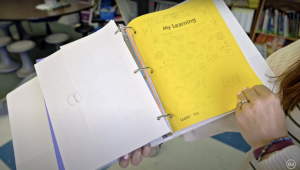Overwhelmed and Overcommitted: Why Schools Underperform and Struggle to Improve
Author: Sean Covey
September 2, 2025

Four Common Pitfalls and How to Overcome Them
In every school system, the gap between intention and impact is persistent, and often misunderstood. Most educators are working harder than ever. Many schools are mandated to manage more initiatives than ever. Yet the gains are often uneven and hard to sustain.
Over the past two decades, I’ve worked with hundreds of schools across the country and around the world. I’ve seen schools with plenty of resources and those facing real challenges both wrestle to turn effort into lasting progress. But I’ve also seen schools of every kind rise above the odds and do something remarkable. The difference rarely comes down to funding, curriculum, or leadership charisma. More often, it comes down to something deceptively simple but remarkably hard to sustain: delivering a breakthrough result that requires your entire staff to change their behavior, in an environment where your “day jobs” are already all-consuming.
The demands placed on schools today are real and rising: Lift test scores. Adapt to new technologies. Manage emerging social stressors. Implement new teaching models. Retain teachers. The instinct is to respond with more: more programming, more plans,more urgency. But when everything becomes urgent, nothinggets the sustained attention it needs. Teams stretch their energy across too many fronts. Success becomes difficult to define, let alone achieve.
I often visit schools where teams are juggling multiple improvement efforts—literacy pilots, instructional coaching, school culture work. Each initiative is well-intentioned and backed by strong research. They often show promise at first. But then progress stalls. Principals will tell me: “My teachers can’t handle one more thing on their plate.”

Their experience is not unique. FranklinCovey’s work in the business world has long centered on helping organizations execute under very similar conditions. Its 4 Disciplines of Execution (4DX) model was developed to help business leaders focus large, complex organizations on a few critical goals that truly move the needle—starting with the recognition that even well-intentioned strategies will stall under the weight of competing demands.
Since its introduction into education, FranklinCovey’s 4DX model and Leader in Me initiative has helped school leaders build a system of total alignment, cascading from district-wide strategic plans down to school, classroom, and student level goals, creating an environment where educators and students take ownership of the district’s academic and strategic initiatives. The context may differ, but the challenge—and the solution—remains the same: do fewer things, and do them well.
This report explores four common pitfalls that school leaders encounter, and provides real-world examples of how the 4 Disciplines can serve as their antidote and a gateway to outperformance.
- We start with the tendency of schools to set too many goals—and how Discipline One, Focus on the Wildly Important, helps narrow attention to what matters most.
- Then we look at the problem of using the wrong metrics to track success, and how Discipline Two asks us to Act on Lead Measures—the specific behaviors that drive results.
- Next comes the pitfall of progress that no one can see, against which Discipline Three urges that we Keep a Compelling Scoreboard to engage and motivate all stakeholders.
- And finally, schools may find themselves falling off track over time; Discipline Four helps organizations Create a Cadence of Accountability that sustains momentum and fosters ownership.
In our experience, these pitfalls show up again and again in schools that are working hard but struggling to gain traction. For leaders caught in the middle of them, it can be a frustrating and often puzzling experience; the causes aren’t always clear. But when applied with intention, the 4DX framework helps schools recognize the patterns that are holding them back and build the habits that can move them forward. It offers a way to turn their good intentions into real, lasting progress.
Too Many Goals, Not Enough Progress
What FranklinCovey saw in the business world—organizations struggling to gain traction under the weight of too many priorities—is just as pervasive in education. School and district improvement plans often have as many as 30 goals: boost academic scores, close achievement gaps, improve attendance, strengthen culture, elevate engagement. Even with the best of intentions, when every goal is treated as equally urgent, schools risk mistaking movement for progress. Energy gets spread too thin. Attention scatters. Despite the appearance of momentum, little actually moves.
The pressure to improve on all fronts is real. New mandates tied to test performance, family engagement, and funding can leave school leaders managing a swirl of initiatives without a coherent throughline. Teachers experience it as noise. Students feel the inconsistency. And what begins as urgency too often turns into fatigue.
Even absent improvement plans, fragmentation of attention is a feature of classrooms everywhere, a part of life for both students and teachers. According to a 2025 report from Hanover Research, 75% of public schools say that students’ lack of focus or inattention had a moderate or severe negative impact on learning. At the same time, teachers report that their own attention is split between the need to test and the need to teach. Some 62% say that current assessment models interfere with instructional time—far more, by the way, than the 37% of administrators who share that view.
In the absence of clear priorities, both teachers and students struggle to find their footing.
The alternative is deceptively simple: do less, but better. Schools that narrow their focus—and align their teams around that focus—are more likely to gain traction. The answer isn’t to work harder; it’s to choose what matters most and execute with clarity.
In the business world and in education, FranklinCovey’s implementation of The Four Disciplines of Execution (4DX)—has consistently found that organizations that set 1-2 “Wildly Important Goals” are likely to achieve them, and those that set 4 or more goals, are likely to achieve none of them. We’ve seen this play out in schools, and districts. Republic School District was one such case.
Case Study: Republic School District (Mo.)
Republic School District, located in southwest Missouri, serves more than 5,000 students across seven schools, from preschool through grade 12. Some 40% of students qualify for free or reduced-price lunch. Minority enrollment is 24%. When Republic began its work with FranklinCovey’s whole school transformation program Leader in Me, in 2016, its seven schools were underperforming significantly, with average state test scores ranging from 52% to 78%.
But what Republic now describes as its leadership journey didn’t start with a districtwide mandate. It started small, with a faculty book study at a single elementary school. Teachers at Sweeny Elementary decided to read The 7 Habits of Highly Effective People, that my father Stephen R. Covey wrote. Soon they began weaving the 7 Habits into their classrooms, as a framework for how students and adults alike could approach their work and participation at school. Small changes accumulated quickly. Within a year, the impact was visible in the way students set goals, reflected on their growth, and supported one another.
Encouraged by Sweeny’s success, the district made a key decision. Notably, it didn’t launch ten new initiatives but went all in on the one that was working. By 2019, all seven schools in the district had adopted Leader in Me, giving Republic a shared foundation for leadership and learning.

Applying the 4DX through their Leader in Me implementation, the district aligned around a small number of Wildly Important Goals (WIGs) to bring consistency and clarity to its improvement plans. Schools set targeted goals around key priorities such as attendance, behavior, and academic growth. Students set goals of their own and tracked progress in leadership portfolios. Staff used shared scoreboards to make data visible and meaningful. And throughout the district, in classrooms and leadership team meetings alike, conversations shifted from compliance to ownership.
The result was measurable. The district’s school with the lowest state test scores, Schofield Elementary, saw them rise from 52% to 88%, placing it in the top 10% of schools in the state. Chronic absenteeism across the district dropped to 15.6%, well below the Missouri average of 21.8%. Republic High School’s graduation rate reached 96.3%, nearly ten points above the national average. Sweeny, a better-performing school from outset, gained 14 points pushing its average to 88%. These gains didn’t come from chasing more but from committing to less, and following through.
How Focus Drives Execution
Republic’s success reflects a core principle of the 4DX: focus is the foundation of progress. The first discipline in particular, “Focus on the Wildly Important,” asks leaders to resist the pull of everything and instead commit to the one or two outcomes that would make the greatest difference. In schools where competing priorities are the norm, 4DX provides a structure to surface what matters most, and to stay with it long enough to see results.
By aligning district, school, and student-level goals around those priorities, and using visible scoreboards to track them, Republic created a culture of clarity and ownership. What started as a single goal in a single school became a systemwide shift. The district had the courage to focus.
Measuring Results, Ignoring What Drives Them
Most schools live by what the business world calls lag measures. These are outcomes like test scores, attendance rates, and graduation percentages. They are important benchmarks, but they don’t show what’s happening in real time to drive improvement. Schools often have no choice but to focus on such numbers, but the problem is this: they don’t offer real-time insight, which is what they really need to make progress happen. That result is frustration, stagnation, and missed opportunities.
Lag measures are easy to report and understand, but they come too late to influence. A school-wide attendance rate of 85 percent might signal a problem, but only after months of absences have gone unaddressed. Meanwhile, teachers and students feel subject to systems they can’t change. The remedy lies in lead measures—specific, actionable behaviors that predict goal achievement and can be controlled daily. Without anchoring in lead measures, even the best-defined, most closely-watched targets can drift away.
Schools that achieve meaningful gains don’t abandon lag measures but supplement them with lead measures that drive action. They track behaviors like timely attendance interventions, goal-tracking rituals, or completion of targeted assignments. Even better if the students themselves design their lead measures, making a bet that the behaviors they will measure in themselves will improve the chances of the school achieving its goal. This provides early signals that the work is taking hold. With the right focus and rhythm, lead measures give teachers and students a sense of control, and a visible path to progress.
Case Study: Jones County School District (N.C.)
In 2018, Hurricane Florence brought widespread destruction to eastern North Carolina. Jones County Schools were hit hard, with two school buildings lost and students displaced for more than two months. Then came the COVID pandemic and—after new state accountability guidelines were issued—the district found itself labeled as low-performing. It was a hard moment. “That’s where we were at our low,” one member of the team, an instructional coach, recalled. “And we needed something to help us get back to where we knew we could be.”
District leaders responded by engaging their entire community. Families, educators, and community members came together for town halls and data nights to name what mattered most: subject-matter proficiency, graduation rates, attendance, and behavior. Bringing everyone together, compiling that list, was a clarifying and unifying process to be sure. But the feeling didn’t last because the list was long, and overwhelming, and presented the district with a new challenge: Execution.
 To develop a strategy focus, Jones County turned to Leader In Me. They began by identifying a relatively small number of WIGs, including graduation rates. But just as critical in the process was identifying the lead measures that would drive them: end of grade and end of course proficiency, compulsory attendance, and student behavior. These metrics could be tracked and influenced daily. Educators focused on keeping students present and on track in the classroom. Students, too, set goals and monitored their own progress; choosing how they would celebrate success when they met their targets.
To develop a strategy focus, Jones County turned to Leader In Me. They began by identifying a relatively small number of WIGs, including graduation rates. But just as critical in the process was identifying the lead measures that would drive them: end of grade and end of course proficiency, compulsory attendance, and student behavior. These metrics could be tracked and influenced daily. Educators focused on keeping students present and on track in the classroom. Students, too, set goals and monitored their own progress; choosing how they would celebrate success when they met their targets.
The results were decisive. Jones County achieved the second-highest graduation rate in North Carolina, and all five schools in the district received state recognition for academic growth, with some schools improving academic scores by as much as 14%. Over the past three years, the district has seen a 311% increase in the number of students performing at grade level—far outpacing the average growth of surrounding districts. What changed wasn’t just the vision but the ability to execute. “Students are being driven at a higher level,” the district superintendent reflected. “And they’re holding themselves accountable.”
From Measurement to Momentum
Jones County’s progress was driven by many factors, but changing what they measured day to day was a crucial one. That shift lies at the heart of FranklinCovey’s 4DX. Specifically, Discipline 2, “Act on the Lead Measures,” challenges schools to identify the high-leverage actions that predict success and stay within their control. In the case of compulsory attendance, an action framework might look like this:
- Know the behavioral drivers. Maintain awareness of them throughout the day and week (e.g., consistent morning routines, timely parent communication, daily student check-ins).
- Make the lead measures visible. Use tools like classroom trackers, daily attendance dashboards, or simple check-in charts.
- Check them frequently. Weekly review sessions, led by teachers or students, make it clear whether the behavior is sticking and help flag patterns early.
- Adjust quickly. If attendance slips, dig into the reasons: Are students disengaged? Are there avoidable barriers? Use that insight to adjust routines or supports before the problem compounds.
In practice, this approach serves two purposes. First, it connects action to outcome, giving stakeholders clarity about what actually works. Second, it fosters daily choices. Students, teachers, and families can see how they influence results, gradually turning lag measures into lived accountability.
Schools that track lead measures alongside lags report higher engagement, stronger buy-in, and a cultural shift from external compliance to internal momentum. They no longer wait for reports but pilot proactively. The lesson here is simple: if you want to move outcomes, measure the behaviors that change those outcomes.
Communicating Goals Without Creating Engagement
Setting clear goals is essential, but clarity alone doesn’t drive motivation. In many schools, objectives are posted, mission statements are visible, and test data is widely shared. Yet without meaningful engagement from students, even well-designed plans fail to gain traction. Students may understand what they’re expected to achieve, but they don’t always feel connected to the process of getting there.
That’s because engagement is emotional as well as cognitive. Engagement driven by experiences that make progress feel real—where effort is recognized, feedback is immediate, and success is visible along the way. Absent those cues, motivation erodes. What schools need isn’t just more communication about goals, but better design of the student experience that surrounds them.
Practical Applications: Silver Lake Elementary (Del.), ATLAS Elementary (Calif.)
Silver Lake Elementary in Middletown, Del., is a powerful example of engagement in action. As a Leader in Me Lighthouse School, it has earned the highest level of recognition within the program’s framework. That distinction reflects a culture where student goal-setting and self-management are visible, personal, and consistently celebrated. One FranklinCovey team member recalled a moment that captured just how deeply engagement runs at the school.
Walking down the hall at Silver Lake one day, I saw a girl come out of her classroom with a huge grin on her face, admiring a lanyard hanging from her neck. The lanyard read: “I achieved my goal!” As she approached me, I congratulated her, and she happily pointed to a sticky note she had placed on her chest that said, “76 wpm (words per minute) 97% accuracy! WOW!” I responded with, “Congratulations. That is a big accomplishment; you must have worked hard to achieve this goal.” Her response was filled with wonderment: “Yes, and you know I was only aiming for 87%.”
After sharing her news with a school staff member in the hallway, the student then went to share the news with the principal and to call home. The school’s approach to recognizing effort made the moment both memorable and motivating; it was a marker of personal growth and the student herself knew that.
ATLAS Elementary, a Title I K–8 school in Ventura, California, reinforces this idea at scale. Every student selects a personal WIG tied to the school’s themes: Learn, Love, and Lead. Some goals are academic, others are about health or habits, but all are meaningful to the student. They’re tracked in student-kept Leadership Notebooks and updated visibly on classroom scoreboards. One class holds weekly pep talks to build momentum.
The visuals matter. When students see progress on a wall, when they move a marker or update their chart, the experience becomes interactive. These simple tools transform goals from abstract ideas into something tangible and motivating. The scoreboard becomes a source of energy rather than pressure.
Designing for the Winnable Game

FranklinCovey’s third discipline—Keep a Compelling Scoreboard—is designed to elevate engagement through visibility and relevance. A well-constructed scoreboard provides information, of course, but it also invites participation. It helps students see that their efforts are making a difference, that progress is happening now, not just later.
This is the essence of the winnable game. Students are more likely to engage when they believe success is within reach and when the path to it is visible. Scoreboards turn progress into something concrete. When students can move a tracker, update a chart, or cross a threshold they’ve been working toward, the whole process changes. Far from resting on their achievement, they see a game that they can win and that they want to keep playing.
In the right conditions, scoreboards don’t simply track, they energize. They shift the conversation from performance to progress, from pressure to momentum.
Expecting Accountability Without Ownership
Accountability is often treated as a system of oversight, implemented through evaluations, metrics, and external checks. But performance rarely improves when goals are handed down and compliance is enforced from the top. Teachers may cooperate, and students may meet expectations, but the work lacks energy and resilience. Progress built on pressure alone doesn’t last.
When teams set their own goals, track their progress with their peers in a regular cadence, and see themselves as responsible for results, the dynamic changes. True ownership and accountability take hold.
Principals become visible participants, not just evaluators. Teachers make adjustments because they want to improve, not because they’re told to after a classroom visit. And students begin to see achievement as something within their control.
If a team meets regularly and shares their progress and activities with one another to help reach a goal, everyone becomes more invested. They will feel as though they are playing a winnable game. That’s builds engagement, and momentum.
In Practice: Republic School District (Mo.), ATLAS Elementary (Calif.)
For Republic School District in Missouri, ownership was central to the strategy. Leaders knew that meaningful improvement would require buy-in as well as focus. Through FranklinCovey’s 4DX, they built both. Each school set a small number of WIGs, often tied to academic growth in literacy or math. But crucially, individual teams and staff members had a say in defining the WIGs and how they would contribute to them.
At Sweeny Elementary, the focus was on student engagement during reading blocks. Teachers helped define the lead measures—like minutes of active reading time—and monitored those indicators daily. Classrooms tracked results visibly. When engagement dipped, teachers adapted. When progress occurred, it was celebrated. The goal was collective, but the execution was personal. Ownership meant teachers played an active role in both setting the direction and making it stick. As a result, Sweeny saw almost a 20% increase in their test score average. (2016-2024)
This wasn’t limited to educators. Students, too, set individual learning goals tied to the school’s priorities. In many classrooms, students used tracking tools to monitor their own progress and reflected on what was working. These weren’t compliance rituals but were designed instead to create a sense of control, progress, and self-respect.
ATLAS Elementary in California echoed this model. Teachers selected their own WIGs aligned to the schoolwide focus and posted them publicly. Students did the same. They set personal goals connected to the broader “Learn, Love, Lead” framework. Over time, these habits of alignment and visibility created a culture of mutual accountability: each person had a voice, and each person had a role.
Accountability That Starts With a Choice
FranklinCovey’s fourth discipline—Create a Cadence of Accountability—supports both sides of ownership: it keeps execution active and respects each person’s autonomy in the process. In practice, this means brief but consistent check-ins where team members report on past commitments, review the scoreboard, and commit to next steps. These conversations are forward-looking and team-owned. They’re not performance reviews. They’re a collaborative, mutually supportive practice.
When applied well, this discipline makes accountability feel less like a judgment and more like a commitment. Progress becomes something teams and individuals choose to pursue, and keep choosing, week after week. That voluntary repetition is what builds trust, consistency, and long-term results.
Accountability is earned by giving people a voice in setting goals and a role in achieving them. That’s the real lesson: if you want students, teachers, or leaders to take responsibility, you have to give them something real to own.
‘Step Out of The Whirlwind’
The reality is, schools today are being asked to do more than ever—often with fewer resources and less time. The instinct is to take on everything at once: every initiative, every metric, every new demand. But my experience across thousands of schools teaches something else: Progress comes from doing less, and doing it better. That’s what the Four Disciplines are all about: narrowing the focus, acting on what you can influence, making progress visible, and staying with it long enough to see it through.
I often tell school leaders: You can’t land seventeen planes at once. You can only land one at a time. You’ve got to choose the one that matters most and bring it in safely. The others won’t disappear; they’ll keep circling. But your team will gain energy and clarity by seeing one thing through. And often, when you’ve landed that one plane, the others will start lining up better on their own.
We know educators can’t abandon “the day job”—the dozens of urgent tasks that require their attention. What they can do is step out of the whirlwind just long enough to focus on what makes a critical difference.
Here’s my challenge to you: Look at your school or district improvement plan. Ask yourself and your team: What’s the one outcome that, if we improved it, would make the biggest difference? Set that goal, define the behaviors that will get you there, and commit to measuring them every week. You’ll be surprised how quickly momentum builds. These are the same principles we’ve seen work in business, and we’ve seen them transform schools. The key is focus. The rest follows.
